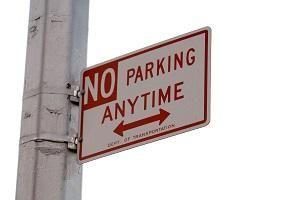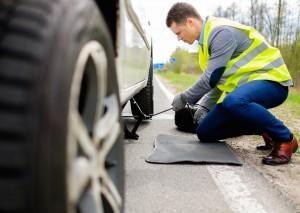7/31/24
Garfield and AAA : Keep Your Children Safe in the Car
7/28/24
Inspecting and Maintaining Tires Will Minimize Roadside Service Calls

It is well documented that the No. 1 cause of roadside service calls is tires. No wonder, there are 18 tires on a typical line-haul service vehicle, more tires than any other vehicle component. You can have the best vehicle maintenance program on the planet, but once that truck leaves the terminal, a number of tire issues can occur that can lead to a roadside service call.
Tread area punctures are the top cause of air loss. A tire failure depends on the size of the puncturing object, in combination with the specific penetration location. If that nail penetrates through one of the tread grooves, chances are higher the nail will break through the tire casing, causing air loss. Tires do not normally have a sudden air loss when a vehicle picks up a puncturing object; they lose air slowly. It may take a few days to lose enough air pressure where the tire sidewalls begin excessive flexing, which generates additional heat build-up.
The tire footprint becomes longer as the tire pressure is reduced, meaning more rubber on the road—which also leads to increased heat. Heat is a tire’s worst nightmare. When a tire continues to generate excessive heat, the rubber actually begins to chemically break down, which will lead to a tire failure. The fact that someone just checked all 18 tires at the morning vehicle walk-around has no bearing on picking a up a nail five minutes down the road.
Sidewall damage/snags are another cause of tire failure. Right side or curb side trailer tires are especially prone to sidewall issues. Vehicles that turn frequently in city driving have the highest incidence of tire sidewall damage. Driver education can play a major role in reducing trailer tire sidewall damage. Drivers who have been on the road for many years will have fewer trailer tire sidewall damage issues than a new driver.
When a vehicle is pulled over for a roadside inspection, tires are high up on the inspector’s checklist. Inspectors are looking for tires with tread depth below the minimum 4/32-in. for steers and 2/32-in. for drives, trailers and dollies. They also are looking for exposed belts and/or fabric along with flat tires. By definition, a tire is flat when the measured air pressure is 50% or less of the maximum tire pressure molded onto the tire sidewall.
If any of these tire conditions are present, the vehicle is flagged as being “out-of-service.” A roadside service call is the only solution for getting the truck up and running again.
There is no excuse for a fleet to have an inspector flag its vehicle as being out-of-service because of a tire-related issue. These types of tire conditions should have been caught during the daily vehicle walk-around. Drivers must be trained to visually inspect tires, take tread depths and even measure tire pressure. It sounds like it is routine, but it’s not. Working with your tire professional on a tires 101 training class will go a long way to reduce roadside service calls.
Visual tire inspections should include running a hand over the tread and sidewall to look for signs of irregular wear and punctures. If a tire is getting close to the legal tread depth, a tread depth gauge measurement is strongly suggested. Make sure to check that the tread depth gauge measures 0 on a flat. Don’t take a measurement at a treadwear indicator location or on top of one of those stone ejectors located at the bottom of many grooves. If you do, you could be off 2/32-in. or 3/32-in.
Measuring tire pressure using a calibrated pressure gauge is very critical. Air carries the load, and tires with low air pressure will lead to excessive heat and premature tire removals. Tire gauges are simple devices, but will quickly lose accuracy. Even a new stick gauge is only accurate to +/-3 PSI brand new, out of the box.
A serious tire program, which includes comprehensive driver training regarding tires, will go a long way in reducing-tire related roadside service calls.
Learn more at: http://www.fleetequipmentmag.com/reducing-tire-related-roadside-service-calls/
7/25/24
Cognitive Distraction
7/22/24
Driving Defensively for CDL Drivers
This training video is for Commercial Drivers License CDL holders and teaches them how to drive defensively while operating big rig, semi trucks and other large delivery vehicles.
7/19/24
Why do Cars Get Impounded?
Impounded cars
are those placed in tow yards legally before they are returned back to
their owners, recycled, auctioned or completely destroyed. Impounding
agencies must have a legal right before impounding a vehicle. The agents
tow the vehicle once they find it in their list of automobiles for
impounding.

Auctioning of abandoned vehicle is often organized to assist in recovery of cash used during towing and the time the auto was stored in the yard. This is usually done if the owner of the vehicle is not found, the owner doesn’t want the car anymore or if the vehicle has overstayed in the yard.
Before retrieving your impounded vehicle, you first need to understand why it was impounded in the first place. This will allow you plan accordingly.
Reasons cars get impounded
-
i. Driving with no license
ii. Possession of a stolen car
iii. Car was involved in an accident
iv. The car isn’t insured
v. Over speeding
vi. Your car was found abandoned on the road
vii. Driving under suspension
viii. Outstanding fines for parking
-
ix. Driving under the influence of alcohol or drugs
x. If your car got involved in assaulting someone
xi. If the car is not correctly parked
xii. Your registration is expired
xiii. If you are violating traffic rules
xiv. Driving vehicles that are not roadworthy
xv. If your car is exposing the public to potential health hazards or any other risks
Has the vehicle been impounded illegally?
In case your car gets impounded illegally, contact a criminal defense lawyer to help you fight for your lawful rights. Most people with impounded cars often make claims of ownership and get collection letters. Once at the correct impounding station, you’ll be needed to prove your identity and ownership of the car.Sometimes, you might not be able to retrieve your car by yourself due to unavoidable circumstances. If you’d wish to send someone on your behalf, let them bring with them a letter of authorization signed by you, a copy of your driving license and an insurance certificate to prove your identity.
The cost of retrieving your vehicle
Getting your car back for free is almost impossible; there are fees that must be paid before you get your car. The police or private agencies charge you storage and towing fees. All your outstanding charges and fees must be cleared. Abandoning your vehicle because you don’t want to pay charges is not advisable.It might result in your car being auctioned or completely destroyed. Afterward, you won’t have any claim for that car. The impounding agencies would benefit from auctioning your car. Even so, the municipal or companies you owe debts for years would still want you to pay them.
What You Might Not Know About Using and Maintaining Your Spare Tire
Source: https://www.fifetowing.com/blog/why-cars-get-impounded/
Your Message
7/16/24
Out of Control Big Rig Trucks Are Causing Horrible Accidents
America’s truckers have played a huge role in getting goods across the country, but has the pressure to keep store shelves stocked led to danger on the roads? Every day, there are more than 5,500 accidents involving big trucks that lead to injury or even death. Experts say a person is killed or seriously injured in an accident caused by a semi-truck about every 15 minutes. Inside Edition hit the highway with Indiana state trooper Anthony Emery, who stopped and gave warnings to several truckers for speeding and cellphone use. #InsideEdition #IEInvestigates
7/13/24
Forces and Motion – Collisions
7/10/24
AAA Video Showing Roadside Dangers for Tow Operators Urging Public to Pay Attention
Take a look at the new Video Produced by AAA showing the motoring public the dangers the towing community faces just doing their job. We highlight how Industry Partners like AAA are bringing Slow Down, Move Over Awareness into focus. This video is powered by OMG National. OMG NATIONAL an INC 5000 Company that provides Custom Website Design, Search Engine Optimization, LOCAL Directory development & promotion, Social Media Development, Review management, Pay Per Click administration and of course...Telephone On-Hold Messages. https://omgtowmarketing.com/
7/07/24
Watch This Incredible Heavy Duty Rollover Recovery in Action!
Pepe's Towing Service
81.8K subscribers
7/04/24
7/01/24
The Physics of Car Crashes
How is the chemical energy of gasoline transformed into kinetic energy of a moving car? And where does that kinetic energy go when the car crashes into something and stops moving?
Thanks to Ford (http://www.takeagoodlook.com) for sponsoring this video.
Link to Patreon supporters here: http://www.minutephysics.com/supporte...
Music by Nathaniel Schroeder, http://www.soundcloud.com/drschroeder
MinutePhysics is on Google+ - http://bit.ly/qzEwc6
And facebook - http://facebook.com/minutephysics
And twitter - @minutephysics
Subscribe to:
Posts (Atom)

